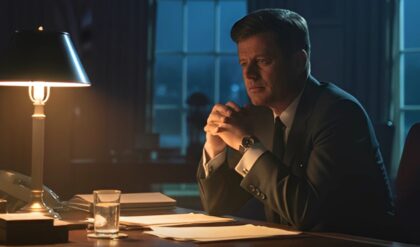In the annals of Hollywood thrillers, few films have managed to capture the raw intensity and claustrophobic suspense of Panic Room (2002), directed by David Fincher. This gripping home-invasion thriller marks the first and only collaboration between two powerhouse actresses, Jodie Foster and Kristen Stewart, whose on-screen chemistry as mother and daughter elevates the film to a modern classic. With a tightly woven script by David Koepp, a stellar supporting cast, and Fincher’s meticulous direction, Panic Room remains a pulse-pounding blockbuster that holds up as a must-watch for thriller enthusiasts. Here’s why this film, born from a turbulent production yet executed with brilliance, deserves a place in the pantheon of great suspense cinema.
A High-Stakes Premise in a Claustrophobic Setting
Panic Room tells the story of Meg Altman (Jodie Foster), a recently divorced mother, and her 11-year-old daughter, Sarah (Kristen Stewart), who move into a sprawling brownstone on New York City’s Upper West Side. The house, previously owned by a reclusive millionaire, comes equipped with a high-tech “panic room”—a fortified chamber designed to protect occupants during a break-in. On their first night, the unthinkable happens: three intruders—Burnham (Forest Whitaker), Junior (Jared Leto), and Raoul (Dwight Yoakam)—invade the home, searching for $3 million in bearer bonds hidden in the panic room’s floor safe. Meg and Sarah take refuge in the room, setting the stage for a tense game of cat-and-mouse where the very sanctuary meant to protect them becomes the focal point of danger.
The film’s premise is a masterclass in simplicity and suspense, drawing inspiration from real-world news about panic rooms in 2000 and echoing classic thrillers like Wait Until Dark (1967). Koepp’s script taps into universal fears of home invasion, amplified by the post-9/11 climate of paranoia when the film was released in March 2002. The confined setting of the brownstone, combined with the high stakes of protecting a child, creates a pressure-cooker atmosphere that keeps viewers on edge for its 112-minute runtime.
Jodie Foster and Kristen Stewart: A Mother-Daughter Dynamic for the Ages
The heart of Panic Room lies in the compelling dynamic between Foster and Stewart, whose performances as Meg and Sarah are both authentic and deeply affecting. Jodie Foster, already a cinematic icon with two Academy Awards for The Accused (1988) and The Silence of the Lambs (1991), brings a steely resolve to Meg, a woman navigating the aftermath of divorce while fiercely protecting her daughter. Foster’s ability to convey both vulnerability and resourcefulness makes Meg a relatable yet heroic figure. Her performance is particularly striking in moments of quiet desperation, such as when she risks leaving the panic room to retrieve Sarah’s diabetes medication, showcasing a mother’s unyielding determination.
Kristen Stewart, only 11 at the time and in one of her earliest major roles, holds her own alongside Foster. As Sarah, a diabetic tomboy with a sharp wit and quiet courage, Stewart delivers a performance that feels remarkably mature for her age. Her naturalistic acting complements Foster’s intensity, creating a believable mother-daughter bond that grounds the film’s high-stakes narrative. Scenes where Sarah teaches Meg to swear convincingly or calmly manages her medical condition under pressure highlight Stewart’s precocious talent, foreshadowing her future as a celebrated actress. Posts on X have praised their casting, with one user calling Fincher “a genius” for pairing them, noting how their physical and emotional resemblance enhances the film’s realism.
Their chemistry is no accident. Foster, who replaced Nicole Kidman after an injury forced Kidman to drop out 18 days into filming, brought a new depth to Meg. Originally written as a more helpless character, Meg was rewritten to be stronger and more akin to Sarah with Foster’s involvement, aligning with Foster’s legacy of portraying resilient, gender-defiant women. Stewart, who replaced Hayden Panettiere, was chosen for her ability to match Foster’s intensity, and their off-screen rapport—evident in Foster’s later praise of Stewart as a “kid” who left her “in awe”—translated into a dynamic that feels lived-in and authentic.
David Fincher’s Technical Mastery
David Fincher, coming off the cult success of Fight Club (1999), brings his signature precision to Panic Room, transforming a straightforward thriller into a visual and emotional tour de force. Known for his obsessive attention to detail, Fincher saw the film as a chance to craft a “lurid thriller” that didn’t take itself too seriously, likening it to Hitchcock’s “slices of cake” rather than profound social commentary. Yet, his technical prowess elevates the film beyond its B-movie roots.
The film’s opening credits, set to Howard Shore’s ominous score and featuring aerial shots of Manhattan with text seemingly embedded in the architecture, set a tone of grandeur and unease. Fincher’s use of CGI-enhanced camera work, including a bravura shot that flows through the house’s impossible crevasses, establishes the brownstone’s geography with crystalline clarity. This technical innovation ensures that viewers remain oriented during the chaotic set pieces, heightening the suspense without disorienting the audience. Critics, including Roger Ebert, praised Fincher’s “visual virtuosity” and his ability to create a chess-like game where characters operate as strategic players rather than pawns.
The brownstone itself, built on a Raleigh Studios lot, is a character in its own right. Its cavernous spaces and the panic room’s cold, steel-encased interior amplify the film’s themes of isolation and vulnerability. Fincher’s use of sound design—distant creaks, muffled voices through walls, and the hum of surveillance monitors—further immerses viewers in the claustrophobic terror. The film’s pacing, described as “pacy and gritty” by IMDb reviewers, ensures that its nearly two-hour runtime feels relentless, with no slow moments despite the confined setting.
A Supporting Cast That Adds Depth
The intruders—Burnham, Junior, and Raoul—are brought to life by a talented trio of actors who add complexity to the antagonist roles. Forest Whitaker’s Burnham, a security expert with a moral compass, is a standout, with Whitaker delivering what some critics call one of his finest performances. His empathetic portrayal makes Burnham a reluctant criminal, creating tension within the group. Jared Leto’s Junior, the trust-fund grandson of the house’s previous owner, is snarky and impulsive, while Dwight Yoakam’s Raoul, a ruthless hitman, exudes chilling menace. Their differing motivations—greed, survival, and violence—create a volatile dynamic that keeps the narrative unpredictable.
The interplay between the intruders and the Altmans mirrors the strategic maneuvering of a chess game, a comparison Ebert noted in his review. Each character’s decisions, from Meg’s calculated risks to Burnham’s attempts to de-escalate, drive the plot forward, ensuring that the film remains engaging even as it unfolds in a single location.
Cultural Context and Lasting Impact
Released in the spring of 2002, Panic Room tapped into the post-9/11 zeitgeist, where fears of invasion and loss of security were palpable. While not explicitly about terrorism, the film’s exploration of domestic vulnerability and the commodification of fear resonated with audiences, contributing to its $196.4 million worldwide box office haul against a $48 million budget. Its commercial success, including a $30 million opening weekend, marked a personal best for both Foster and Fincher at the time.
Critically, Panic Room received mixed-to-positive reviews, with a 75% rating on Rotten Tomatoes. Critics lauded Foster’s performance and Fincher’s craftsmanship but noted that the film’s conventional plot and crowd-pleasing finale didn’t match the ambition of Fincher’s other works like Se7en or Fight Club. Some scholars, however, have since praised its feminist undertones, with Lynne Stahl arguing that Meg and Sarah’s gender nonconformity and resistant motherhood challenge traditional norms, aligning with Foster’s career-long exploration of female autonomy.
Despite its critical and commercial achievements, Panic Room is often overshadowed by Fincher’s more celebrated films, with some calling it “Minor Fincher.” Yet, its enduring appeal lies in its accessibility and rewatchability. Posts on X reflect ongoing fan appreciation, with users calling it “fun and intense” and praising the Foster-Stewart dynamic. The film’s recent announcement of a 4K UHD release in February 2025 and a Brazilian remake in development underscore its lasting relevance.
Why Panic Room Is a Must-Watch
Panic Room is more than just a thriller; it’s a testament to the power of great performances, meticulous direction, and a tightly crafted story. Jodie Foster and Kristen Stewart’s singular collaboration delivers a mother-daughter dynamic that is both emotionally resonant and thrillingly intense, anchoring a film that balances heart-pounding suspense with human stakes. Fincher’s technical brilliance and the strong supporting cast elevate a simple premise into a cinematic experience that feels fresh even two decades later.
Whether you’re drawn to the Hitchcockian tension, the stellar acting, or the exploration of fear and resilience, Panic Room offers something for every viewer. It’s a blockbuster that doesn’t sacrifice substance for style, making it a timeless addition to the thriller genre. So, dim the lights, lock the doors, and experience this electrifying film—you’ll be on the edge of your seat, rooting for Meg and Sarah until the very last frame.





